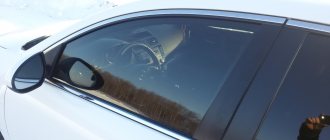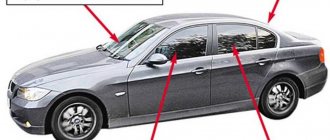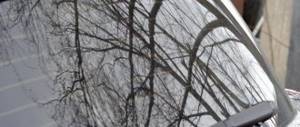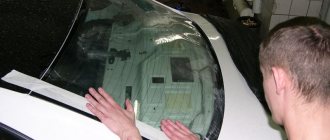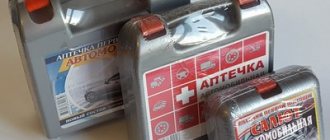AutoUrayt.rf / Questions
Back
Published: 03/02/2020
Reading time: 3 min
0
999
Car window tinting has long become one of the most popular vehicle tuning procedures. But athermal film, designed to increase the level of comfort in the cabin, appeared relatively recently. In this regard, many drivers have questions about the admissibility of its use.
- What is athermal tinting, differences from regular tinting?
- Requirements for light transmittance of glass according to traffic regulations and GOST
- Mirror athermal film is prohibited
- What athermal film is acceptable?
- What is the fine for athermal tinting?
- Tinting and modifications to the design
- conclusions
What is athermal tinting, differences from regular tinting?
Some car manufacturers provide a thermal windshield. Those who purchased a model that does not have this part have the opportunity to make adjustments themselves by gluing a special film.
Unlike conventional tinting, athermal coating blocks 99% of the sun's rays from penetrating into the interior. Infrared radiation is blocked by 50%, while light transmittance can be maintained at 85% compared to completely transparent glass.
The advantages of thermal tinting include the following points:
- It’s comfortable to be in the cabin, even if the car has been standing for a long time under the scorching rays of the sun;
- preventing deformation and burnout of plastic elements;
- slowing down the wear and tear of fabric upholstery and leather seats;
- in summer you have to turn on the air conditioning less often, which helps save fuel;
- the film can protect the driver if the windshield is damaged, since most of the fragments will not scatter throughout the cabin, but will be fixed by the coating.
It is worth paying attention to the disadvantages of such tinting:
- film from leading manufacturers is not cheap;
- tinting with a blue tint can contribute to rapid eye fatigue;
- radar detectors and some other devices may react to metallized coating;
- During operation, the light transmission capacity of the glass decreases, and they no longer comply with established standards.
To minimize the disadvantages of thermal films, you should give preference to high-quality products and follow the rules for applying tinting.
Athermal film consists of several layers:
- protective covering;
- adhesive layer that absorbs UV rays;
- a tinted or transparent layer with the same effect;
- metallized coating that reflects infrared radiation;
- transparent polyester;
- anti-scratch coating.
Requirements for light transmittance of glass according to traffic regulations and GOST
Clause 7.3 of the Road Traffic Regulations states that it is prohibited to operate a vehicle if it is equipped with coverings or objects that interfere with the driver’s normal visibility. It is further explained:
More on the topic: Fine for curtains on the side windows of a car
- Colored transparent films can be attached to the top of the windshield.
- You can use tinted glass (in addition to mirror glass) with light transmission in accordance with GOST 5727-88.
- The rear windows of passenger cars are allowed to be covered with curtains or blinds, provided that there are mirrors on the outside located on both sides.
Another document regulating the level of tinting of ground vehicles is GOST 5727-88. Its paragraph 2.2.4 states that glass that provides the driver with a view of the road must have the following level of light transmission:
- wind - from 75%;
- non-wind, included in the front visibility area - from 70%.
The light transmission of non-window glasses that are not included in the standard field of view is not standardized.
It must be remembered that no car glass is 100% transparent. In most cases, this figure is 85-90%. This feature must be taken into account when choosing athermal film. Without special measuring equipment, this will be problematic, so it is recommended to entrust the application of tinting to the employees of a specialized center. They will make sure all necessary measurements are taken and ensure compliance with the law.
Tinted and painted windshields must provide the correct perception of red, green, yellow, blue and white.
Is it allowed to use Chameleon film on a windshield?
There are no regulatory sources that would prohibit the application of Chameleon film to vehicle windows. When deciding whether to equip a car with film, a car owner must take into account the total throughput of the glass after it has been processed. For the windshield the parameter corresponds to 90-95%. When choosing a film with an indicator of 83%, the total light transmittance will correspond to the maximum permissible value of 75%. Using Chameleon film with lower parameters will lead to violation of traffic rules and technological regulations, as a result of which the driver will have to pay a fine.
Example
The light transmittance of the windshield of a vehicle operated by citizen Gurov for two years is 90%. Before purchasing the Chameleon film, he made a simple calculation to determine the parameters of the planned purchase.
0,75/0,9= 0,83 (83 %).
In accordance with the data obtained, he determined that it was possible to purchase film whose light transmittance exceeds 83%. In order to have a small reserve for future wear of the glass and for the errors of the instruments that will be used to check the parameter, the citizen purchased a film with an indicator of 85%.
Mirror athermal film is prohibited
One of the types of athermal tinting is mirror film. Such car tuning cannot go unnoticed by the traffic police. It must be remembered that Decree of the Government of the Russian Federation dated October 23, 1993 N 1090 (as amended on August 27, 2018) “On Traffic Rules” prohibits the use of mirror coatings.
Characteristics of athermal film
Manufacturers of glass films produce their products with different characteristics, expressed in the percentage of darkness, which determines the light transmittance parameter. Athermal film provides 80-90% light transmittance. The nanoceramic coating of the thinnest graphic layer transmits the visible spectrum of light, blocking no more than 25% of the light flux, taking into account the resistance of the equipped glass. The products fully fulfill the functions assigned to them to ensure comfort, protection from hot sunlight and exposure to ultraviolet radiation, and also comply with the regulatory requirements of technological regulations. Vehicle windows equipped with athermal tinting:
- transmit over 75% of the light flux;
- block up to 99% of ultraviolet radiation and 55% of heat.
What athermal film is acceptable?
Athermal tinting is conditionally permitted, but it can be applied to glass only if a number of rules are observed, which some manufacturers neglect.
Most often the question arises whether it is allowed to glue athermal film to the windshield. Yes, but its light transmittance level should not be lower than 70%. You will have to spend time taking measurements, but if the car is new, the efforts will be justified - the standard result after installing the film is 76.5% light transmittance, which corresponds to the norm. After several years of active use, the glass may become cloudier, so it is recommended to repeat measurements periodically.
More on the topic: Is it possible not to sign the protocol and resolution of the traffic police?
Athermal tinting “Chameleon”, capable of changing light transmission depending on the intensity of light, often reflects quite strongly, so the driver may face problems when passing the test. This feature of “Chameleon” is due to the fact that this type of film consists of many metallized layers, which not only change the color of the tint, but also mirror the image.
This film may have different light transmittance depending on the time of day and temperature. Indicators may also vary across the width of the film. It is thanks to these features that the “chameleon” effect is achieved. Unfortunately, models of the domestic automobile industry and inexpensive foreign cars with chameleon film will not comply with the standards established by law, especially if they have been in use for more than one year, and there are cracks or cloudy areas on the glass. There is only one way out - replace the glass with new ones.
Purple athermal tint is most often installed on the rear window because it darkens the windows significantly. It is only allowed to be glued to windows with a light transmittance of at least 91%. This indicator can only be found in new glasses. In addition, the result largely depends on the quality of installation. In the worst case, the scatter can reach 7% in different areas of the glass.
Athermal tinting according to GOST
At the moment, there is no exact GOST that would regulate the requirements for athermal tinting. There are only technical regulations, for non-compliance with which the violator faces a fine. According to the rules, the light transmission of glass must be at least 70% (for side front windows), and 75% (for the windshield).
It is important to know that 100% light transmittance does not exist among glasses. The maximum result is 90%, and using the best athermal film it is impossible to get more than 85%. If we take average statistics, the situation becomes even more complicated - most glass from manufacturers has an initial light transmittance of 80-85%, then there is a high chance that if low-quality athermal tinting is used, this parameter will drop below 75%, which will be a violation of current legislation. Athermal windshield tinting is not well suited for the budget segment of cars; the film greatly reduces light transmittance and will require frequent glass replacement.
It should also be taken into account that after several years of active use, the light transmission of the windshield in all cars drops by about 10%. As a result, if initially this parameter was 80% with athermal tinting, then after 2-3 years it will decrease to 70% and below, which will also lead to fines. Therefore, it is important that the windshield and side front windows have very good light transmittance, since otherwise it will not be possible to install tinting.
Many manufacturers have begun to make athermal glass tinting, and often the light transmittance is 75%, which no longer falls under GOST. This led to the introduction of a new GOST, according to which the light transmittance should already be above 70%. This is due to the fact that the government did not dare to ban the sale of a huge number of cars, which could lead to large-scale problems. Overall, how does this impact the end consumer of the film?
An example of installed athermal tinting. Result BEFORE and AFTER:
What is the fine for athermal tinting?
The characteristic blue-violet or greenish tint of athermal film often attracts the attention of traffic police officers. The inspector has the right to stop the driver at any time for inspection. Measurements of the light transmittance of glass are made with special equipment. For the device to work correctly, the following conditions must be met:
- the surface being studied is dry and clean;
- ambient temperature – from 15 to 25 C, humidity – from 40 to 80%, atmospheric pressure – from 86 to 106 kPa;
- the device is sealed and has a certificate of conformity;
- the documents accompanying the equipment must contain a note indicating that an annual mandatory inspection has been completed;
- According to the requirements of clause 4.7 of GOST 5727-88, to determine the level of light transmission, it is necessary to take measurements of three glasses at three points and determine the average value of the obtained indicators.
The person who carries out the measurements must be a traffic police officer or have the appropriate permit.
More on the topic: Fine for not having a compulsory motor liability insurance policy
If a violation is detected, an appropriate resolution is issued. As stated in Part 3.1 of Art. 12.5 of the Administrative Code, the fine for applying athermal tinting that impairs the ability of glass to transmit light is 500 rubles. But even such a relatively small sanction is quite unpleasant for the driver.
In addition, the inspector may require immediate removal of the film. Such a requirement is contrary to the law, but it will be difficult for an untrained driver to argue that vehicles can move further with tinted windows.
Despite the fact that traffic police officers are instructed to take measurements at eye level of the person sitting behind the wheel, they often study the upper left corner, which can be problematic. Therefore, car owners should ensure that all areas of the glass comply with the standards.
Tinting and modifications to the design
Any actions that have been performed on the vehicle are considered changes to its design. But some of them do not need to be registered with the traffic police:
- Tuning, which is provided for in the car’s operating instructions, for example, installing a radio receiver.
- Placement of equipment or spare parts from another company certified as part of this vehicle. A common example is replacing branded wipers with non-original ones. It is enough that there is a mark on the packaging stating that the wipers are certified as part of the car brand.
- If the certificate attached to the athermal film indicates that it was tested as part of a given brand of vehicle, or the instructions for the car say about the possibility of applying tinting. In this case, it is important to ensure that the ability of the glass to transmit light meets the standard. If these conditions are not met, you will have to go through the registration procedure.
conclusions
- Tinting, including using films, is permitted by law.
- Mirror tinting is not acceptable.
- The light transmission level of the windshield, front side windows (if equipped) and front door windows should not be less than 70%.
- Tinting of other windows, including the rear one, is not standardized. They can be made completely opaque. The only condition is that there are rear-view mirrors on both sides of the car.
- A colored stripe up to 140 mm wide can be applied to the top of the windshield. The strip must be transparent and not obstruct the view.
Athermal tinting of car windows according to GOST.
Athermal is a tinting approved according to GOST with a high level of insulation of heat and ultraviolet rays, which practically does not allow losses in light transmission and does not impair visibility. The glass is not tinted, except that it has a characteristic green or blue tint depending on the brand and production technology.
Attention: when applying a low-quality film, this effect will significantly affect the strain on your eyes.
Athermal coating will not protect your interior from unwanted glances, but the temperature difference in summer reaches 30%, which is very noticeable. In addition to preserving the integrity of the interior elements and the temperature inside it, high-quality athermal films ensure that up to 80-85% of light rays enter the cabin, which gives an additional handicap when calculating the final light transmittance of the glass, according to GOST requirements. The thing is that the windows of even new cars transmit only 90-93% of light, and if we talk about used models, then this figure drops to 85%-87%, which makes it impossible to use conventional tinting without violating established standards. While athermal (0.85 * 0.85 = 0.72) will still fit within the GOST framework. Thanks to this feature, this type of coating can be used, including for windshield tinting. The cost of applying athermal film is slightly higher than that of a conventional coating and directly depends on the size of the car windows.
